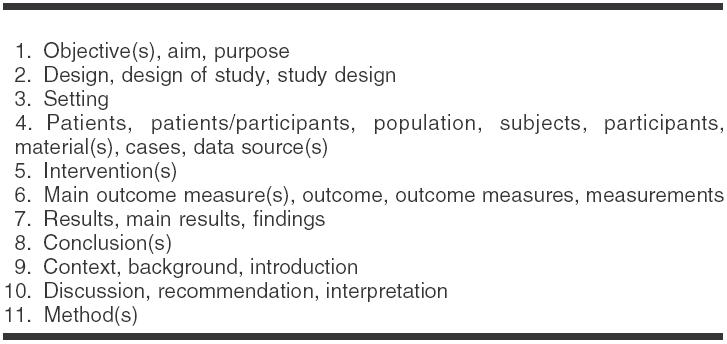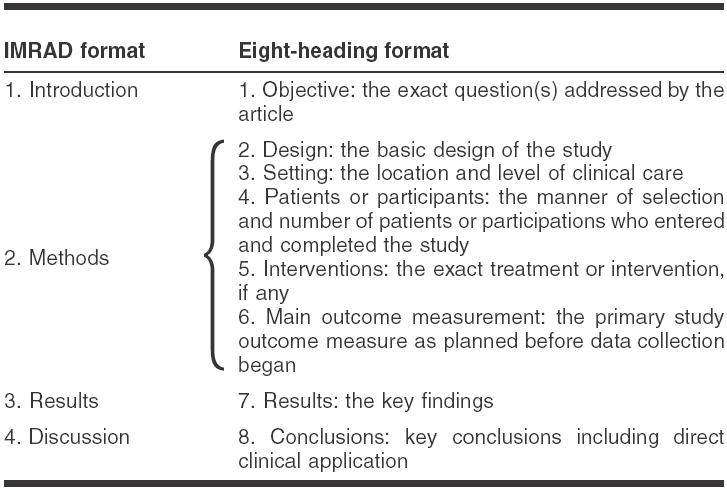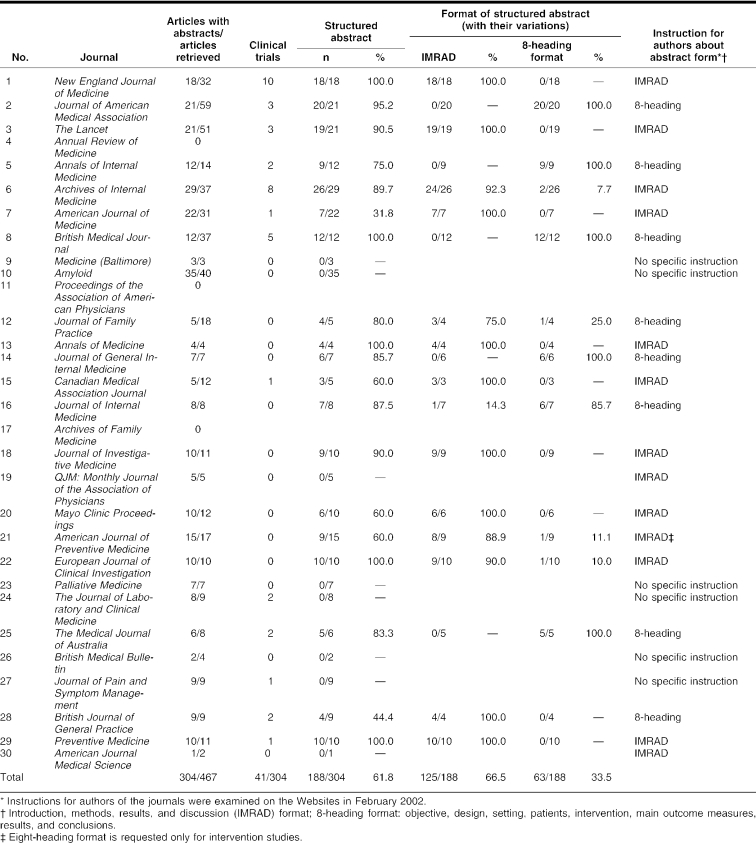Abstract
Background: The use of a structured abstract has been recommended in reporting medical literature to quickly convey necessary information to editors and readers. The use of structured abstracts increased during the mid-1990s; however, recent practice has yet to be analyzed.
Objectives: This article explored actual reporting patterns of abstracts recently published in selected medical journals and examined what these journals required of abstracts (structured or otherwise and, if structured, which format).
Methods: The top thirty journals according to impact factors noted in the “Medicine, General and Internal” category of the ISI Journal Citation Reports (2000) were sampled. Articles of original contributions published by each journal in January 2001 were examined. Cluster analysis was performed to classify the patterns of structured abstracts objectively. Journals' instructions to authors for writing an article abstract were also examined.
Results: Among 304 original articles that included abstracts, 188 (61.8%) had structured and 116 (38.2%) had unstructured abstracts. One hundred twenty-five (66.5%) of the abstracts used the introduction, methods, results, and discussion (IMRAD) format, and 63 (33.5%) used the 8-heading format proposed by Haynes et al. Twenty-one journals requested structured abstracts in their instructions to authors; 8 journals requested the 8-heading format; and 1 journal requested it only for intervention studies.
Conclusions: Even in recent years, not all abstracts of original articles are structured. The eight-heading format was neither commonly used in actual reporting patterns nor noted in journal instructions to authors.
INTRODUCTION
To assist clinicians in quickly finding articles that are both scientifically sound and applicable to their practices, the Ad Hoc Working Group for Critical Appraisal of the Medical Literature proposed, in 1987, a seven-heading format for informative abstracts in clinical articles [1, 2]. Accepting Altman's proposal [3], Haynes et al., in 1990, revised the format and content requirements for structured abstracts to an eight-heading format (objective, design, setting, patients, intervention, main outcome measures, results, and conclusions for original articles) [4]. In 1993, the International Committee of Medical Journal Editors (the so-called “Vancouver group”) recommended, in the “Uniform Requirements for Journals Submitted to Biomedical Journals,” the use of structured abstracts [5]. Following these proposals, medical journals in Europe and the United States have tried to provide more informative abstracts for articles of clinical interest.
Whether the adoption of structured abstracts could improve the quality of articles continues to be controversial [6, 7]. However, it is certain that structured abstracts make it easier for clinical readers to select appropriate articles more quickly and facilitate peer review before publication. Secondary journals like the ACP Journal Club, published by the American College of Physicians, are recognized as valued information resources for practicing evidence-based medicine [8] and have adopted structured abstracts. Harbourt et al. [9] reviewed articles listed on MEDLINE from 1989 to 1991 and found 3,873 articles that included structured abstracts; both the number of articles with structured abstracts and the number of journals publishing them had increased. Kulkarni [10] reported that 28.5% of clinical trial reports listed on MEDLINE in the first half of the 1990s included structured abstracts and that number continued to increase to 71% by the latter half of 1995. Even in non-English-speaking countries, increasingly more journals are adopting structured abstracts; however, the number of structured abstracts provided by journals differs significantly between countries [11, 12].
The introduction, methods, results, and discussion (IMRAD) format [13, 14] and the eight-heading format are well known for structured abstracts in original articles. However, no recent data exist on how many journals provide structured abstracts and what abstract format is required. No systematic research has been conducted on the content of the journals' instructions for authors regarding structured abstracts.
This study was conducted to find out how many original articles published in well-known medical journals included structured abstracts, to identify the formats of such structured abstracts, and to see what abstract format the journals required, structured or otherwise, and, if structured, which format.
METHODS
The top thirty journals according to impact factors noted in the “Medicine, General and Internal” category of ISI's Journal Citation Reports (2000) were selected. Although impact factors are not directly related to journal quality [15, 16], they can be used as an objective selection criteria for journals given that they reflect a journal's impact in terms of how often it is cited.
An investigation was conducted to identify how many of these journals provided structured abstracts as of January 2001. Because four journals (Annual Review of Medicine, Amyloid, Annals of Medicine, and British Medical Bulletin) had an insufficient number of original articles in the January 2001 issue, the investigation continued into February 2001. PubMed was used to extract the abstracts to examine their formats.
To eliminate manuscripts that were not original, the following categories were excluded from the search: “review,” “meta-analysis,” “historical article,” “legal cases,” “consensus development conference,” “comment,” “guideline,” “practice guideline,” and “biography.” “Meta-analysis” articles resemble original contributions more than traditional narrative reviews. A six-heading format of structured abstracts for review research [4], which is nearly equivalent to a “systematic review” or a “meta-analysis,” was assessed independently from original articles. The authors excluded “meta-analysis” in the present examination to focus on the format of structured abstracts in original articles. A search formula was created as follows:
Journal name [ta] AND 2001/01["] NOT (review[pt] OR meta-analysis[pt] OR historical article[pt] OR legal cases[pt] OR consensus development conference[pt] OR comment[pt] OR guideline[pt] OR practice guideline[pt] OR biography[pt])
To classify the abstract patterns objectively, the authors conducted a cluster analysis (Ward's method) of the structured abstracts extracted from PubMed using statistical software (JMP, SAS Institute). The journals' instructions for authors concerning the format of abstracts were obtained from each journal or collected from Websites in February 2002.
RESULTS
We retrieved a total of 467 hits from 27 journals. No original articles were retrieved from the Annual Review of Medicine, Proceedings of the Association of American Physicians, or Archives of Family Medicine using the above search. The first two journals mainly published papers other than original contributions, and the Archives of Family Medicine ended in 2000. Among them, 304 articles included abstracts, 188 (61.8%) of which were structured, while 116 (38.2%) were unstructured (Table 1). Abstracts provided by the New England Journal of Medicine, British Medical Journal, and 2 other journals were structured, and 70% or more of those in the Journal of American Medical Association (JAMA), The Lancet, and 7 other journals were structured. Twenty of the 21 abstracts provided by JAMA were structured (formats with 8 headings), and 19 of the 21 abstracts provided by The Lancet were structured (IMRAD format). In 5 of the journals, fewer than 70% of the abstracts were structured. All abstracts provided by Medicine, Amyloid, and 6 other journals were unstructured.
Table 1 Abstracts of original articles published in top 30 journals according to the rank of impact factors (Medicine, General and Internal): frequency and patterns of structured abstracts (2001)
Various patterns were observed in the 188 structured abstracts retrieved from our search, and the structured formats varied even in the same journal. Thirty-one headings were identified from the structured abstracts, which were examined and summarized into 11 categories (Figure 1). Headings such as “method and results,” which obviously included 2 different headings in 1, were counted as 2 different headings. Using a dendrogram built by cluster analysis, the structured abstracts were categorized into formats with 8 headings (and their variations) and the IMRAD format (and its variations). Results showed that 125 (66.5%) of the 188 structured abstracts adopted the IMRAD format, and 63 (33.5%) adopted the format with 8 headings.
Figure 1.

Integration of similar headings of the 188 structured abstracts of the original articles
Examination of the journals' instructions for authors indicated that eight journals, including JAMA and Annals of Internal Medicine, used the eight-heading format, while thirteen journals, including the New England Journal of Medicine and The Lancet, used the IMRAD format. Six other journals, including the Annual Review of Medicine and Medicine, did not specifically recommend the use of a structured format. No articles were retrieved via PubMed from the following three journals: Proceedings of the Association of American Physicians, Archives of Family Medicine, and British Medical Bulletin; their instructions for authors were also not available. Twenty-six of the twenty-seven journals examined provided abstracts conforming to the instructions for authors. The Journal of Family Practice indicated eight-heading abstracts were to be used, but three out of the four abstracts retrieved were IMRAD format.
DISCUSSION
The relationship between the 8-heading format and the IMRAD format is shown in Figure 2. The 8-heading format requests authors of articles to specify and detail their research design and results [4]. In structured abstracts, authors are asked to describe their research's limitations [17], which are occasionally obscured in the traditional narrative format of abstracts. Accordingly, diffusion of structured abstracts in medical journals, to rapidly convey necessary information for clinical application, can be said to reflect readers' needs rather than those of authors. For a medical librarian or an informationist, structured abstracts are easier to read and facilitate a quicker assessment of relevant clinical articles expected by clinicians. In light of the proposals noted in the “Uniform Requirements for Manuscripts Submitted to Biomedical Journals” [5], more journals are expected to adopt structured abstracts. However, more than 30% of articles from the top 30 journals did not include structured abstracts in this study. One possible reason for journals not adopting structured abstracts is traditional space constraints for a single article, as narrative abstracts generally increase in length once modified to conform to the structured format [1]. Another reason may be that journals are reluctant to obligate authors to present their study's weak points by writing structured abstracts.
Figure 2.

The relationship between the introduction, methods, results, and discussion (IMRAD) format and the eight-heading format of the structured abstracts
A limited number of journals had only structured abstracts. Among the 304 articles that included abstracts, 61.8% were structured. Sixty-seven percent of the structured abstracts used the IMRAD format, while the 8-heading format was not widely used. Results of the cluster analysis indicated that the IMRAD format mainly included the headings “method(s),” “results,” and “conclusion.” Variations of the IMRAD format also included “objective(s), aim, or purpose”; “patients, participants, population, subjects, and material(s)”; and “discussion, recommendation, or interpretation.” As for the format with 8 headings, “results” and “conclusion(s)” were the only categories generally used. Three additional categories were also identified among those using variations of the 8-heading format; these included “context,” “patient,” and “main outcome measures”; “objective(s),” “intervention(s),” and “main outcome measure(s)”; and “objective(s),” “patients,” and “main outcome measure(s).”
Structured abstracts, particularly those with an eight-heading format, are assumed to be more suitable for interventional studies than for observational studies [7]. However, when our search was limited to “clinical trials” by using PubMed's publication type, we retrieved only a few clinical trials (Table 1). Therefore, we could assume that the eight-heading format, if modified appropriately, could also be applied to abstracts for observational study reports. When the heading of “intervention” is not applied in a cohort study that aims to explore the risk factors of a certain disease, “none” or “not applied” can be included. However, it may be rather difficult to describe the “main outcome measures” in an observational study, which are more exploratory in nature than hypothesis testing. Further discussion is needed to address this issue.
In only eight journals of the present study did the instructions for authors recommend the use of the eight-heading format, and, for the most part, abstract formats conformed to the journals' instructions for authors. In light of differences in time of submission, acceptance, and publication and time of examination of the instructions for authors (February 2002), the present findings did not address the question of whether the abstract formats of published articles were consistent with the instructions for authors.
Because abstract formats are influenced by the publishing journal, the instructions for authors and processes of review and editing play important roles in promoting appropriate abstract formats. As for those abstracts that do not conform to the instructions for authors, two possibilities exist. One is that the abstract was submitted, reviewed, and edited before the instructions for authors had been revised and released, and the other is that the abstract format recommended in the instructions for authors might have been inappropriate for the abstract's contents. Although instructions for authors are essential for controlling the quality of abstracts, their limitations result from being provided prior to article submission. Pitkin and Branagan [18] conducted a study to find out whether giving specific instructions to authors after submission of articles could improve the quality of abstracts in the next submission but were unable to prove the effectiveness of such instructions. Nevertheless, their study emphasized the importance of giving specific and detailed attention to abstracts during the editing process.
Abstracts summarize the information provided in original articles. Improvement in the quality of abstracts would be beneficial to authors, readers, and editors. Further possible studies in this area are: attitudes of journal editors, readers, and authors toward using structured abstracts; reasons why some abstracts do not conform to journals' instructions for authors; desirable abstract formats for observational studies, qualitative research, or case reports; possibilities of incorporating information standardized in structured abstracts into a larger database or a decision-support system; and more. We believe that it would be valuable for established journals to recognize how structured abstracts can improve the quality of their publications.
Acknowledgments
The authors thank Tomoya Masaki for his valuable suggestions.
Footnotes
* This study was supported by a grant from the Ministry of Health, Welfare and Labor, Japan.
Contributor Information
Takeo Nakayama, Email: nakayama@pbh.med.kyoto-u.ac.jp.
Nobuko Hirai, Email: hirai@jamas.gr.jp.
Shigeaki Yamazaki, Email: shige@asu.aasa.ac.jp.
Mariko Naito, Email: mnaito@med.nagoya-u.ac.jp.
REFERENCES
- Ad Hoc Working Group for Critical Appraisal of the Medical Literature. A proposal for more informative abstracts of clinical articles. Ann Intern Med. 1987 Apr; 106(4):598–604. [PubMed] [Google Scholar]
- Huth EJ. Structured abstracts for papers reporting clinical trials. Ann Intern Med. 1987 Apr; 106(4):626–7. [DOI] [PubMed] [Google Scholar]
- Altmam DG, Gardner MJ. More informative abstracts. Ann Intern Med. 1987 Nov; 107(5):790–1. [DOI] [PubMed] [Google Scholar]
- Haynes RB, Mulrow CD, Huth EJ, Altman DG, and Gardner MJ. More informative abstracts revisited. Ann Intern Med. 1990 Jul 1; 113(1):69–76. [DOI] [PubMed] [Google Scholar]
- International Committee of Medical Journal Editors. Uniform requirements for manuscripts submitted to biomedical journals. JAMA. 1993 May 5; 269(17):2282–6. [PubMed] [Google Scholar]
- Taddio A, Pain T, Fassos FF, Boon H, Ilersich AL, and Einarson TR. Quality of nonstructured and structured abstracts of original research articles in the British Medical Journal, the Canadian Medical Association Journal and the Journal of the American Medical Association. CMAJ. 1994 May 15; 150(10):1611–5. [PMC free article] [PubMed] [Google Scholar]
- Scherer RW, Crawley B. Reporting of randomized clinical trial descriptors and use of structured abstracts. JAMA. 1998 Jul 15; 280(3):269–72. [DOI] [PubMed] [Google Scholar]
- Sackett DL, Straus SE, Richardson WS, Rosenberg W, and Haynes RB. Evidence-based medicine: how to practice and teach EBM. (London, UK): Churchill Livingston, 2000. [Google Scholar]
- Harbourt AM, Knecht LS, and Humphreys BL. Structured abstracts in MEDLINE, 1989–1991. Bull Med Libr Assoc. 1995 Apr; 83(2):190–5. [PMC free article] [PubMed] [Google Scholar]
- Kulkarni H. Structured abstracts: still more. Ann Intern Med. 1996 Apr 1; 124(7):695–6. [DOI] [PubMed] [Google Scholar]
- Nakayama T, Yamazaki S. Percentages of reports of clinical trials, written in seven non-English languages, that have structured abstracts. General Med. 2003 Dec; 4(1):7–10. [Google Scholar]
- Aoki M. Structured abstracts and their feasibility in Japan. Igaku Toshokan. 2000 Mar; 47(1):52–60.(Japanese with English abstract). [Google Scholar]
- Hitchcock MA. Writing and publishing research articles. Fam Pract Res J. 1988 Fall–Winter; 8(1):3–16. [PubMed] [Google Scholar]
- MacAuley D. Critical appraisal of medical literature: an aid to rational decision making. Fam Pract. 1995 Mar; 12(1):98–103. [DOI] [PubMed] [Google Scholar]
- Frank M. Impact factors: arbiter of excellence? J Med Libr Assoc. 2003 Jan; 91(1):4–6. [PMC free article] [PubMed] [Google Scholar]
- Nakayama T, Fukui T, Fukuhara S, Tsutani K, and Yamazaki S. Comparison between impact factors and citations in evidence-based practice guidelines. JAMA. 2003 Aug 13; 290(6):755–6. [DOI] [PubMed] [Google Scholar]
- Rennie D, Glass RM. Structuring abstracts to make them more informative. JAMA. 1991 Jul 3; 266(1):116–7. [PubMed] [Google Scholar]
- Pitkin RM, Branagan MA. Can the accuracy of abstracts be improved by providing specific instructions?: a randomized controlled trial. JAMA. 1998 Jul 15; 280(3):267–9. [DOI] [PubMed] [Google Scholar]



